A Novel Droplet Generator and a Bench-Testing Rig Enabling Research on Suspension Droplet Wall Impingement and Particle Deposition
Abstract
1. Introduction
1.1. State-of-the-Art Review
1.2. Research Goal and Tasks
2. Materials and Methods
2.1. Testing Rig
- Hydraulic liquid inlet pressure (pl), which is provided by compressed air in the pneumatic line. The pressure regulator allows for increasing the compressed air pressure up to 4 atm. This pressure is monitored using the pressure indicator (PI).
- Electrical impulse series parameters (Figure 2):
- Piezoelectric voltage (Up), which is controlled by the DC voltage source in a range of 0–200 V.
- The number of supplied electric micro-impulses (micro-impulse count, ) and the duration of the micro-impulse (, in ) are used to achieve the required droplet volume.
- The duration of the last (long) impulse (, in ) is used to pinch off the accumulated drop.
2.2. Droplet Generator Unit
2.3. Substrate Plates
- Glass: borosilicate glass plates (Figure 4a) of the required size were purchased from “Minimed” (Bryansk, Russia).
- Acrylic glass (polymethylmethacrylate) offered the best transparency with low resistance to some chemical components of the suspensions, such as heptanol-1 (Figure 4b). Preparation was carried out on a laser cutting machine.
- Aluminum with the hydrophobic coating NeverWet (Rust-Oleum, Vernon Hills, IL, USA). Cutting of the aluminum plates was carried out on an electric erosion wire-cutting machine (Mitsubishi MV-1200R Advance), followed by polishing of the surface as preparation for applying the hydrophobic coating (Figure 4c).
- Rough glass: borosilicate glass plates of the required size were purchased from “Minimed” (Bryansk, Russia). Sandblasting was performed using an aluminum oxide powder with a F40 grid size of sandblasting mixture to achieve the required surface roughness (Ra > 10) (Figure 4d).
2.4. Suspensions
2.5. Testing Protocol
3. Results and Discussion
3.1. Repeatability
3.2. Realizable Droplet Size Range
3.3. Impact against Substrate and Particle Deposition
3.4. Operational Features of the Droplet Generator
- We use an injector with a piezoelectric element and a return spring. The design allows for rapidly changing the open-closed state and creating impulses: opening and closing durations are in microseconds.
- The use of a piezoelectric element and the rigidity of the structure of the entire setup ensures the repeatability and accuracy of droplet generation.
- The generator control system allows to supply electric single pulses of various shapes and durations and series of pulses, thereby generating drops of a specified diameter in a wide range of sizes (~0.75–4.40 mm).
- The test container prevents the injector from contacting with the test fluid. This allows investigating corrosive liquids and liquids containing solid particles, since they only contact the container. Thus, it offers the facility to generate coarse suspension droplets.
- The container for the test liquid is inserted into the quick-release latch and fixed to the generator by turning the latch. This design allows fast sample changes without the use of tools and additional fasteners.
- The design of the generator provides for changing the size of the container for the test liquid simply by unfastening the quick-release latch.
- The test liquid container has a Luer Lock connector for tight connection with tips of various diameters and shapes.
4. Conclusions
Author Contributions
Funding
Institutional Review Board Statement
Informed Consent Statement
Data Availability Statement
Conflicts of Interest
References
- Masters, K. Spray Drying Handbook, 5th ed.; Longman Scientific & Technical: New York, NY, USA, 1991. [Google Scholar]
- Castrejon-Pita, J.R.; Baxter, W.R.S.; Morgan, J.; Temple, S.; Martin, G.D.; Hutchings, I.M. Future, opportunities and challenges of inkjet technologies. At. Sprays 2013, 6, 541–565. [Google Scholar] [CrossRef]
- Sirringhaus, H.; Kawase, T.; Friend, R.H.; Shimoda, T.; Inbasekaran, M.; Wu, W.; Woo, E.P. High-resolution inkjet printing of all-polymer transistor circuits. Science 2000, 290, 2123–2126. [Google Scholar] [CrossRef] [PubMed]
- Zhao, L.; Yan, K.C.; Yao, R.; Lin, F.; Sun, W. Modeling on microdroplet formation for cell printing based on alternating viscous-inertial force jetting. ASME. J. Manuf. Sci. Eng. 2017, 139, 011005. [Google Scholar] [CrossRef]
- Szczech, J.B.; Megaridis, C.M.; Gamota, D.R. Fine-line conductor manufacturing using drop-on-demand PZT printing technology. IEEE T. Electron. Pack. 2002, 25, 26–33. [Google Scholar] [CrossRef]
- Dijksman, J.F. Hydrodynamics of small tubular pumps. J. Fluid Mech. 1984, 139, 173–191. [Google Scholar] [CrossRef]
- Terwagne, D.; Ludewig, F.; Vandewalle, N.; Dorbolo, S. The role of the droplet deformations in the bouncing droplet dynamics. Phys. Fluids 2013, 25, 122101. [Google Scholar] [CrossRef]
- Harris, D.M.; Liu, T.; Bush, J.W.M. A low-cost, precise piezoelectric droplet-on-demand generator. Exp. Fluids 2015, 56, 83. [Google Scholar] [CrossRef]
- Ionkin, N.; Harris, D.M. A versatile 3D-printed droplet-on-demand generator. Rev. Sci. Instrum. 2018, 89, 116103. [Google Scholar] [CrossRef] [PubMed]
- Kang, S.-H.; Kim, S.; Sohn, D.K.; Ko, H.S. Analysis of drop-on-demand piezo inkjet performance. Phys. Fluids 2020, 32, 022007. [Google Scholar]
- Castrejón-Pita, J.R.; Martin, G.D.; Hoath, S.D.; Hutchings, I.M. A simple large-scale droplet generator for studies of inkjet printing. Rev. Sci. Instrum. 2008, 79, 075108. [Google Scholar] [CrossRef] [PubMed]
- Albadi, A.; Zhang, Y. A versatile droplet on demand generator based on active pressure control. Rev. Sci. Instrum. 2020, 91, 125005. [Google Scholar] [CrossRef] [PubMed]
- Mao, X.; Zhang, L.; Zhao, Z.; Lin, F. Generation of droplets via oscillations of a tapered capillary tube filled with low-viscosity liquids. Phys. Fluids 2017, 29, 067104. [Google Scholar] [CrossRef]
- Kosch, S.; Ashgriz, N. A simple vibrating orifice monodisperse droplet generator using a hard drive actuator arm. Rev. Sci. Instrum. 2015, 86, 046101. [Google Scholar] [CrossRef] [PubMed]
- Onses, M.S.; Sutanto, E.; Ferreira, P.M.; Alleyne, A.G.; Rogers, J.A. Mechanisms, capabilities, and applications of high-resolution electrohydrodynamic jet printing. Small 2015, 11, 4237–4266. [Google Scholar] [CrossRef] [PubMed]
- Ali, A.; Rehman, A.U.; Jan, K.; Faisal, S.; Saud, S.; Adnan, M.; Wahid, F.; Alamri, S.; Siddiqui, M.H.; Ali, S.; et al. Synthesis of silver nanoparticles using Plantago lanceolata extract and assessing their antibacterial and antioxidant activities. Sci. Rep. 2021, 11, 20754. [Google Scholar]
- Derby, B. Additive manufacture of ceramics components by inkjet printing. Engineering 2015, 1, 113–123. [Google Scholar] [CrossRef]
- Miskin, M.Z.; Jaeger, H.M. Droplet formation and scaling in dense suspensions. Proc. Natl. Acad. Sci. USA 2012, 109, 4389–4394. [Google Scholar] [CrossRef] [PubMed]

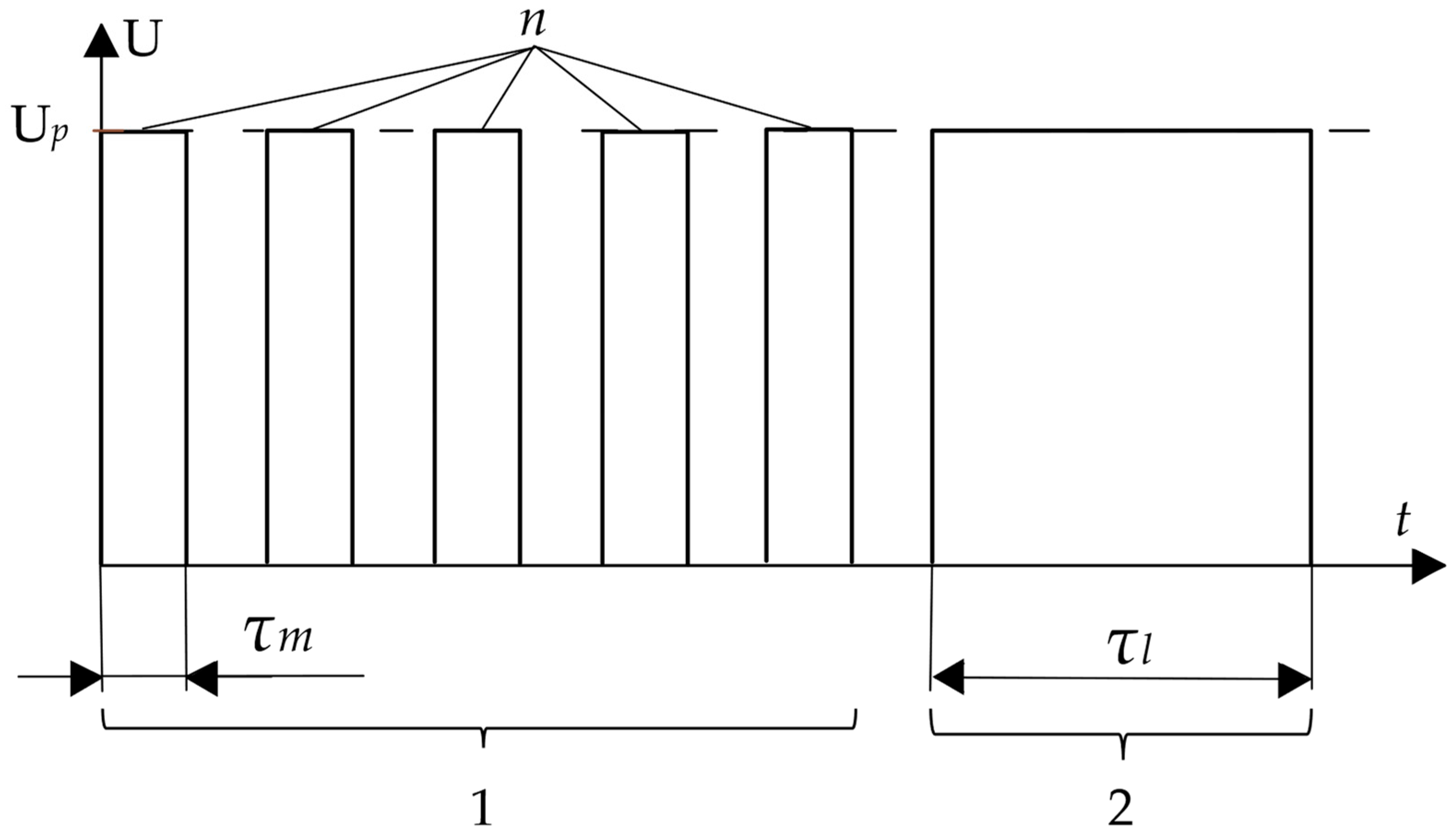
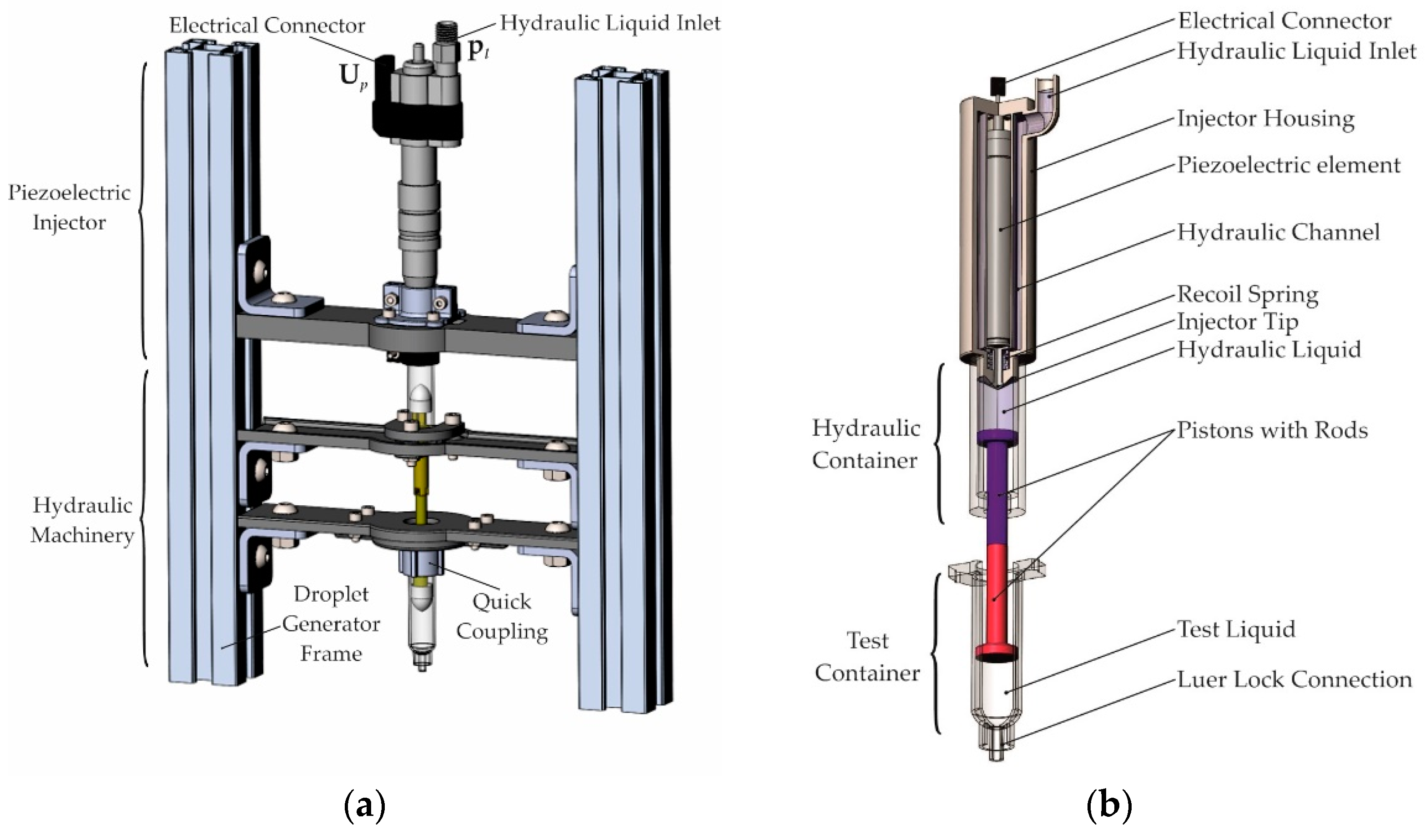
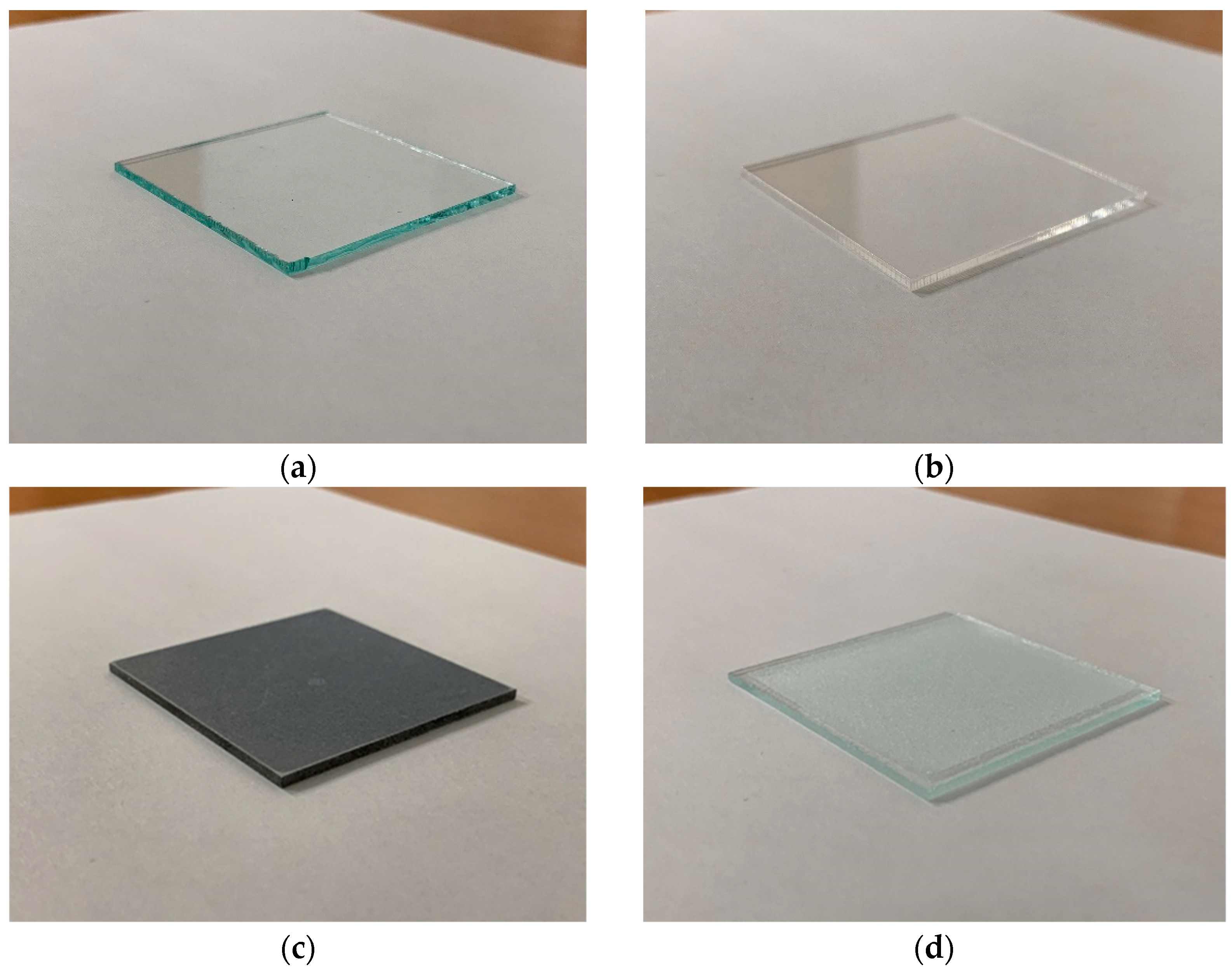

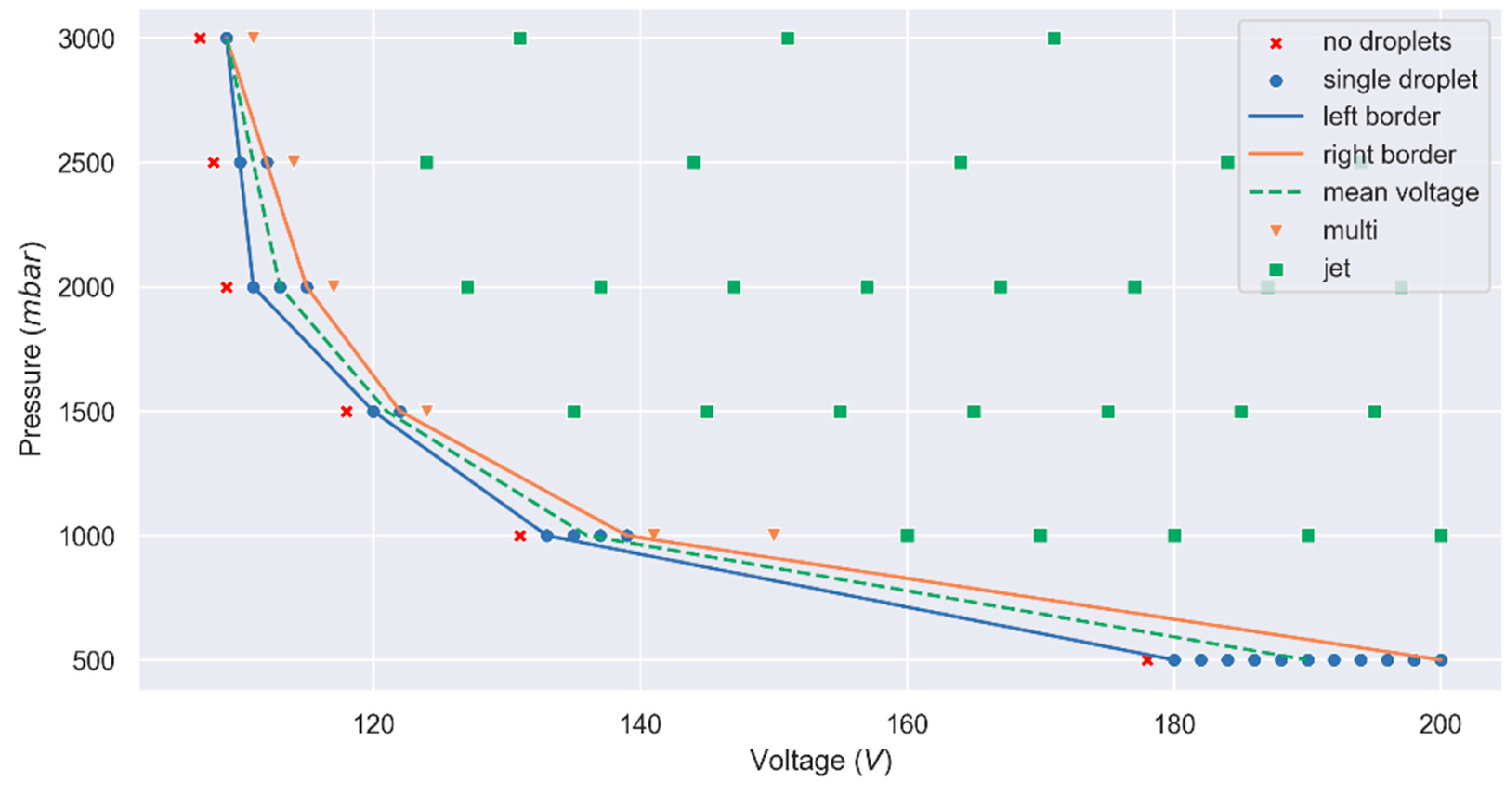
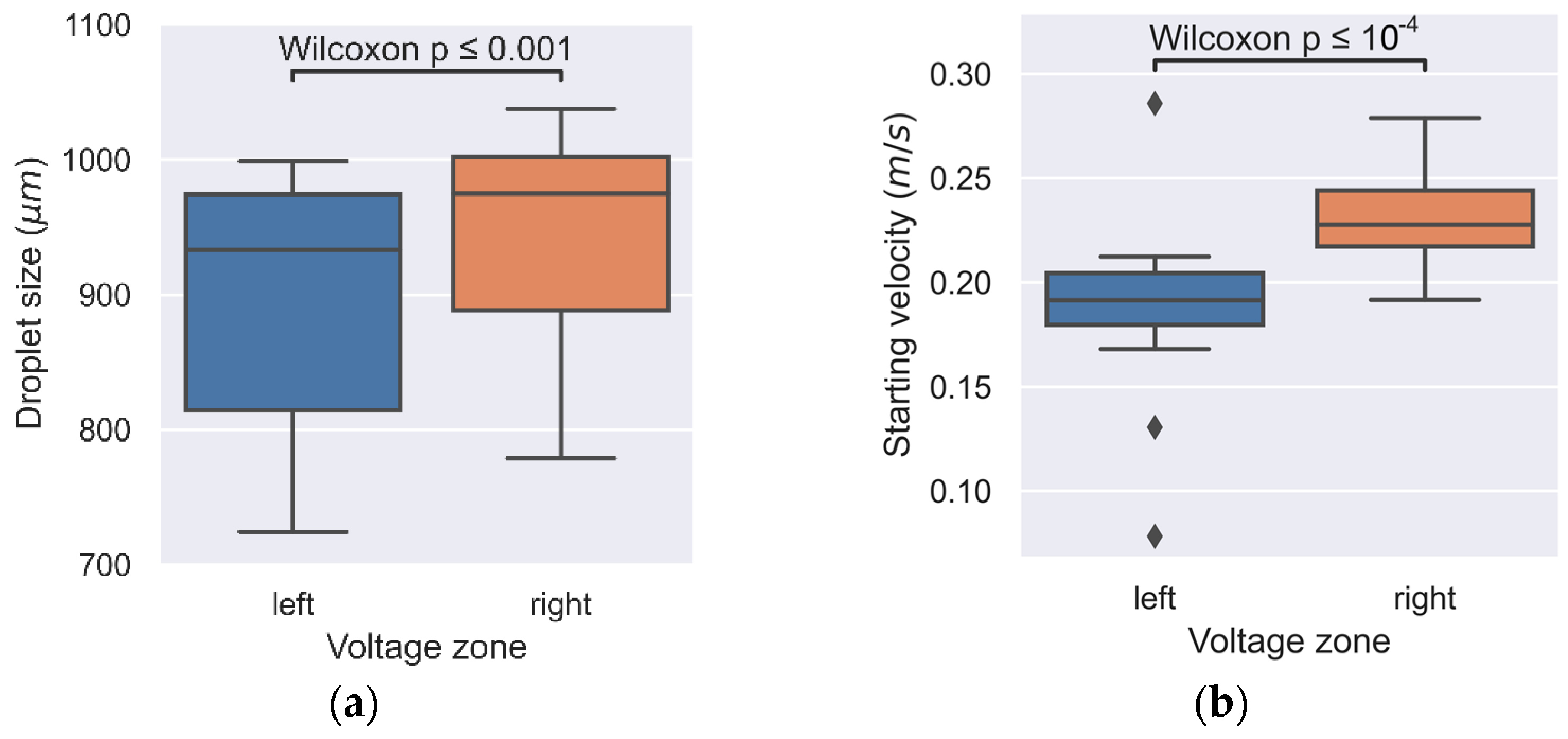
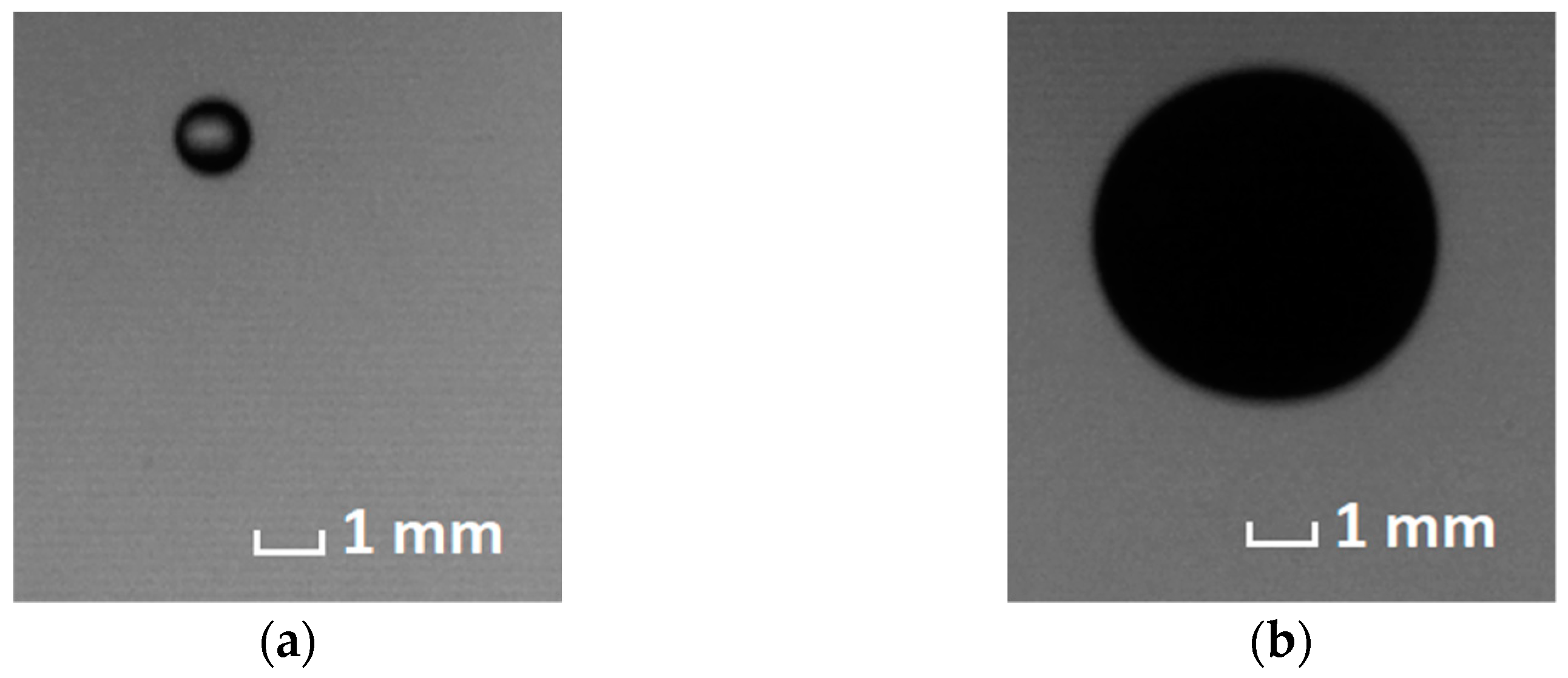
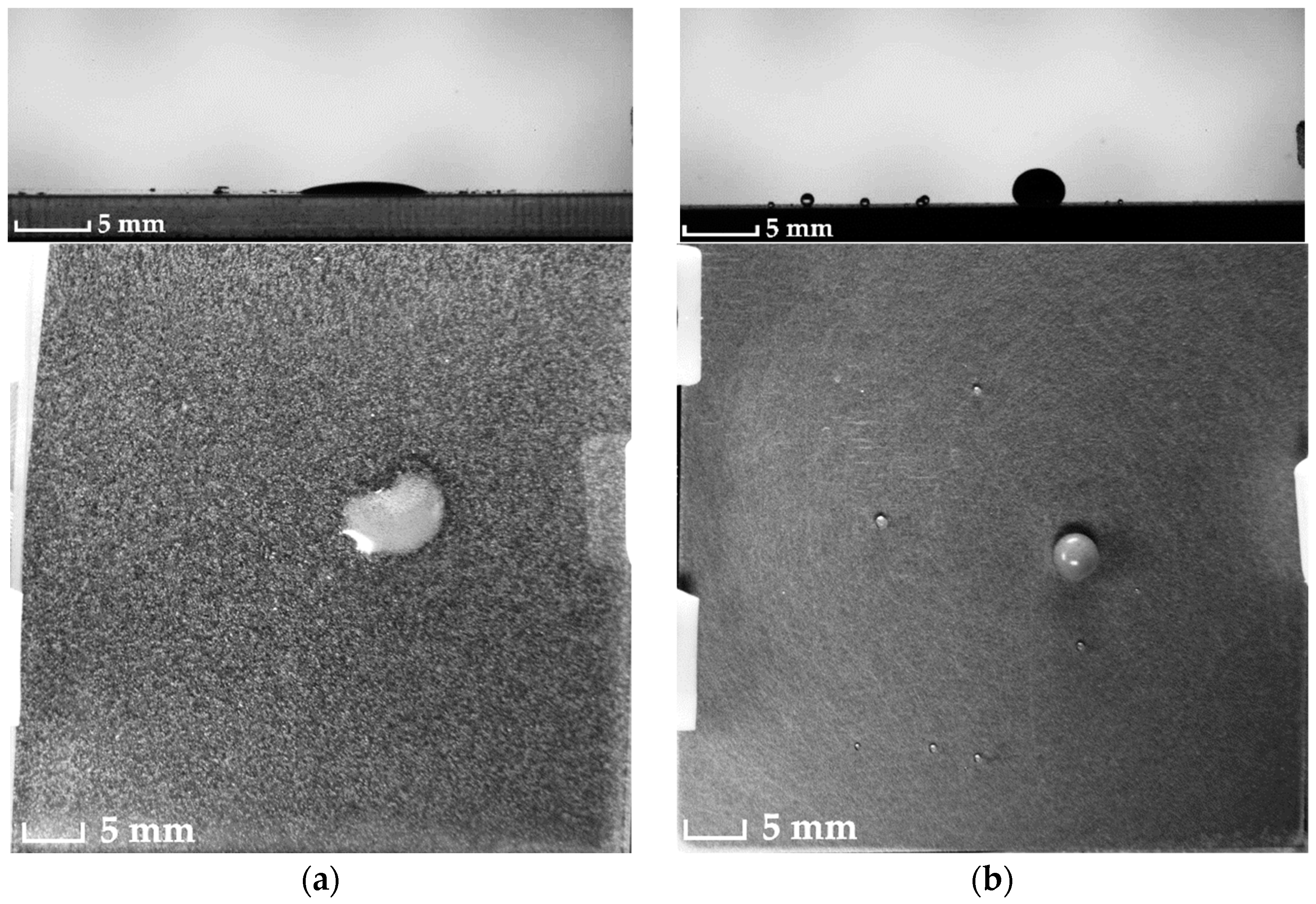


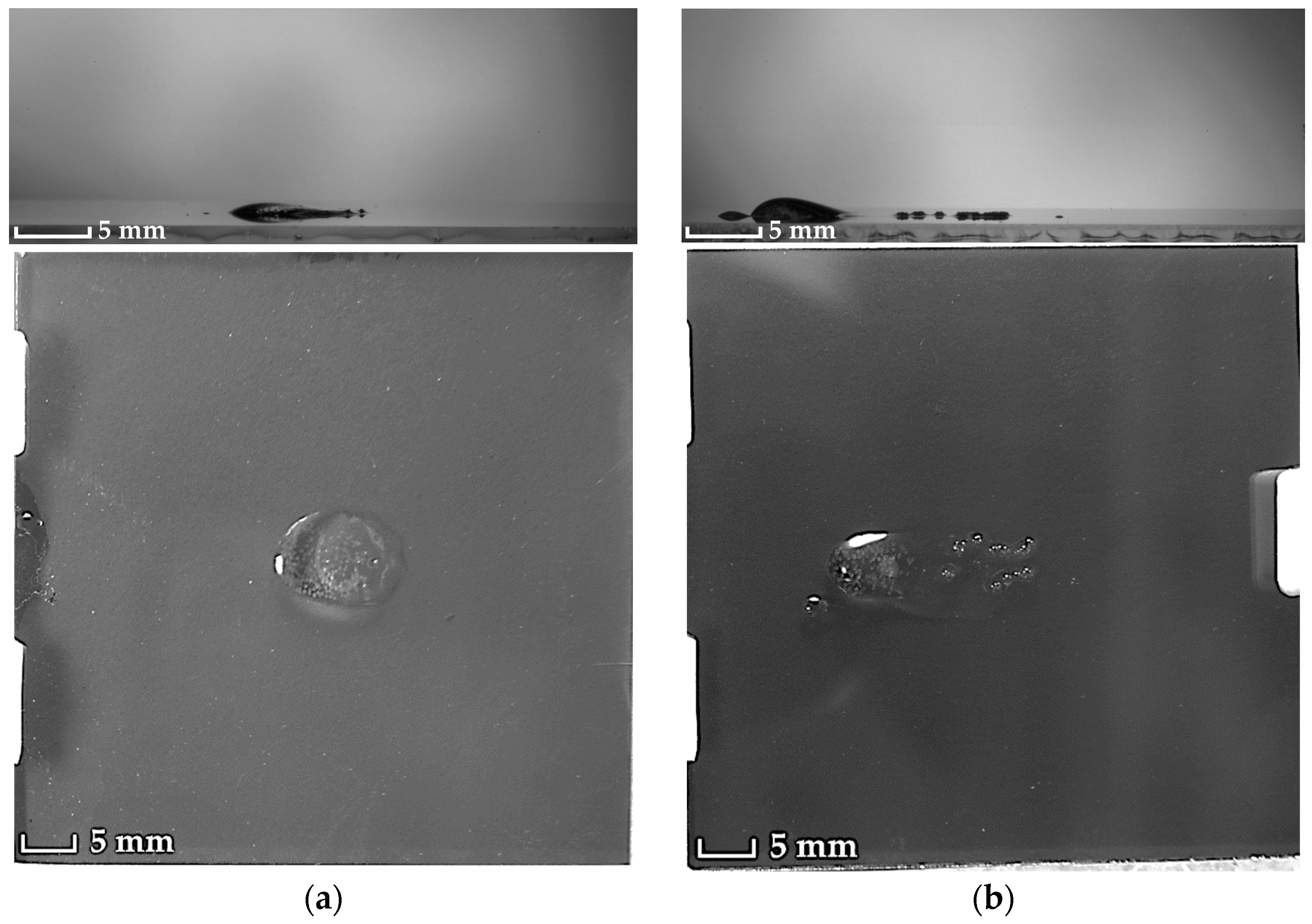
| Substrate Code | Substrate Material | Wettability | |
|---|---|---|---|
| W1 | Glass | Hydrophilic | 0.10 |
| W2 | Acrylic | Neutral | 0.04 |
| W3 | Aluminum with Neverwet | Hydrophobic | 2.49 |
| W4 | Rough Glass | Hydrophilic | 10.89 |
| # | Particles (Table 3) | Liquid (Table 4) |
|---|---|---|
| C1 | polyethylene-S | Heptanol-1 |
| C2 | polyethylene-S | Water |
| C3 | polyethylene-M | |
| C4 | polyethylene-S | 0.75 water + 0.25 glycerol (vol) |
| C5 | polyethylene-S | 0.475 water + 0.525 glycerol (vol) |
| C6 | polyethylene-S | 0.30 water + 0.70 glycerol (vol) |
| C7 | hollow glass | |
| C8 | borosilicate glass | |
| C9 | PMMA-S | |
| C10 | PMMA-M | |
| C11 | PMMA-L |
| Particles | |||
|---|---|---|---|
| hollow glass | 38 | 45 | 450 |
| borosilicate glass | 38 | 45 | 2200 |
| polyethylene-S | 38 | 45 | 100 |
| polyethylene-M | 125 | 150 | |
| PMMA-S | 38 | 45 | 1200 |
| PMMA-M | 125 | 150 | |
| PMMA-L | 250 | 300 |
| Liquid | |||
|---|---|---|---|
| Heptanol-1 | 822 | 6.79 | 26.9 |
| Water | 998 | 1.04 | 73.2 |
| 0.75 water + 0.25 glycerol (vol) | 1064 | 2.05 | 71.3 |
| 0.475 water + 0.525 glycerol (vol) | 1138 | 6.89 | 69.1 |
| 0.30 water + 0.70 glycerol (vol) | 1184 | 23.1 | 67.9 |
| # | Droplet Size, mm | Micro Impulse Count (n) | Micro Impulse Duration (τm), ms | Large Impulse Duration (τl), ms | Needle |
|---|---|---|---|---|---|
| 1 | 0.75 | 0 | 3.0 | 4.0 | Yes |
| 2 | 1.5 | 5 | |||
| 3 | 2.3 | 25 | 4.0 | 12.0 | No |
| 4 | 3.4 | 10 | |||
| 5 | 4.4 | 50 |
| # | Piezoelectric Voltage, V | Droplet Size, mm |
|---|---|---|
| C1 | 105 | 3.23 |
| C2 | 110 | 3.29 |
| C3 | 108 | 3.24 |
| C4 | 105 | 3.19 |
| C5 | 109 | 3.13 |
| C6 | 105 | 3.31 |
| C7 | 111 | 3.12 |
| C8 | 109 | 3.31 |
| C9 | 105 | 3.28 |
| C10 | 108 | 3.27 |
| C11 | 109 | 3.32 |
Disclaimer/Publisher’s Note: The statements, opinions and data contained in all publications are solely those of the individual author(s) and contributor(s) and not of MDPI and/or the editor(s). MDPI and/or the editor(s) disclaim responsibility for any injury to people or property resulting from any ideas, methods, instructions or products referred to in the content. |
© 2023 by the authors. Licensee MDPI, Basel, Switzerland. This article is an open access article distributed under the terms and conditions of the Creative Commons Attribution (CC BY) license (https://creativecommons.org/licenses/by/4.0/).
Share and Cite
Vulf, M.; Petrov, V.; Sulimov, A.; Simonova, A.; Kazak, A.; Chugunov, S.; Kolomenskiy, D. A Novel Droplet Generator and a Bench-Testing Rig Enabling Research on Suspension Droplet Wall Impingement and Particle Deposition. Coatings 2023, 13, 129. https://doi.org/10.3390/coatings13010129
Vulf M, Petrov V, Sulimov A, Simonova A, Kazak A, Chugunov S, Kolomenskiy D. A Novel Droplet Generator and a Bench-Testing Rig Enabling Research on Suspension Droplet Wall Impingement and Particle Deposition. Coatings. 2023; 13(1):129. https://doi.org/10.3390/coatings13010129
Chicago/Turabian StyleVulf, Mikhail, Vladimir Petrov, Artem Sulimov, Anastasia Simonova, Andrey Kazak, Svyatoslav Chugunov, and Dmitry Kolomenskiy. 2023. "A Novel Droplet Generator and a Bench-Testing Rig Enabling Research on Suspension Droplet Wall Impingement and Particle Deposition" Coatings 13, no. 1: 129. https://doi.org/10.3390/coatings13010129
APA StyleVulf, M., Petrov, V., Sulimov, A., Simonova, A., Kazak, A., Chugunov, S., & Kolomenskiy, D. (2023). A Novel Droplet Generator and a Bench-Testing Rig Enabling Research on Suspension Droplet Wall Impingement and Particle Deposition. Coatings, 13(1), 129. https://doi.org/10.3390/coatings13010129








